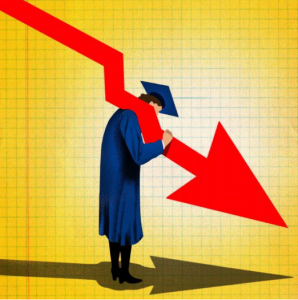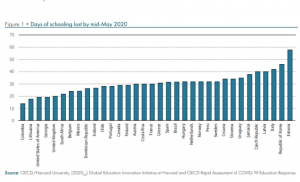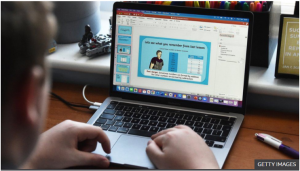
What permanent damage to the economy will the
Covid-19 Pandemic leave behind?
The nationwide
school closures in early 2020 led to losses in learning that will not easily be made up. When children lose out on education, they lose out on future opportunities including economic benefits, such as additional earnings, with far-reaching consequences. Some models suggest that the loss of learning during the extraordinary systemic crisis of World War II
still has negative impact on former students’ lives some 40 years later. The impact of lost learning is not confined to the individual level: For whole societies closing down education last year, there will likely be significant
consequences in the near future.
Education equips people with the skills that make them more productive at carrying out their work tasks, particularly in modern knowledge-based economies. Education also provides knowledge and skills that enable people to generate and apply new ideas and innovations that enable technological progress and overall economic growth.
There are complicating considerations identified. These include uneven quality of learning, differences in provision of effective distance learning, and other pressures that will come to bear on some children, such as the need to find work to help support their families. One can start the analysis by assuming that every additional year of schooling equates to 10 percent in additional future earnings. We then use the number of months of education closures to estimate the loss in marginal future earnings. For example, if Country X closes its schools and universities for four months, the loss in marginal future earnings would be 2.5 percent per year over a student’s working life. We apply this assumption to the world’s largest economy, the United States of America and its 76 million students, as a starting point. We model on a 45-year working life, a discount rate of 3 percent, and mean annual earnings of $53,490, which suggests that the students in grades 1-12 affected by the closures may expect around 3 percent lower income over their entire lifetime. This quick estimate suggests lost earnings of $1,337 per year per student: a present value loss of earnings of $33,464 (63 percent of a year’s salary at current average wage rates). The estimated cost to the United States in future earnings of four months of lost education during the spring and fall of 2020 is $2.5 trillion—12.7 percent of annual GDP.
 The economic losses will be more deeply felt by disadvantaged students. All indications are that students whose families are less able to support out-of-school learning will face larger learning losses than their more advantaged peers, which in turn will translate into deeper losses of lifetime earnings.
The economic losses will be more deeply felt by disadvantaged students. All indications are that students whose families are less able to support out-of-school learning will face larger learning losses than their more advantaged peers, which in turn will translate into deeper losses of lifetime earnings.
There is no doubt that the school closures in 2020 have resulted in significant learning losses to the affected cohort of students – and some of the re-opening strategies being implemented will only further exacerbate these already incurred learning losses. These losses will follow students into the labor market, and both students and their nations are likely to feel the adverse economic outcomes. It is well known that national economies that go forward with a less skilled labor force face lower economic growth, subtracting from the overall welfare of society. Nobody can predict exactly how school closures will affect the future development of students, but past research has investigated how school attendance and learning outcomes affect labor-market chances and economic development.
As schools move to re-establish their programs even as the pandemic continues, it is natural to focus considerable attention on the mechanics and logistics of safe re-opening. These long-term economic impacts also require serious attention because the losses already suffered demand more than the best of currently considered re-opening approaches.
Additionally, it must be noted that the school closures can be expected to have numerous consequences for the socio-emotional and motivational development of the affected children and adolescents. Development in these areas is restricted by the lack of contact with classmates and the psychological strain on families during an extended stay in sometimes cramped housing conditions. The economic impacts of learning losses and socio-emotional skills are likely to negatively impact economic potential.
 In the current economic crisis, policy makers in Washington D.C. are eager to drive the jobless rate down as fast as possible to reverse a new upsurge in long-term unemployment. It is one reason why Treasury Secretary Janet Yellen, a labor economist, has called for Congress to “go big” on a relief package. The future impact of past and future learning losses needs to be considered when it comes to the design of mixed in-person and home learning and when classes are potentially cancelled again locally or regionally due to new infectious viruses. Perhaps legislatures and presidential candidates will have to give more consideration to universal basic income in the near future.
In the current economic crisis, policy makers in Washington D.C. are eager to drive the jobless rate down as fast as possible to reverse a new upsurge in long-term unemployment. It is one reason why Treasury Secretary Janet Yellen, a labor economist, has called for Congress to “go big” on a relief package. The future impact of past and future learning losses needs to be considered when it comes to the design of mixed in-person and home learning and when classes are potentially cancelled again locally or regionally due to new infectious viruses. Perhaps legislatures and presidential candidates will have to give more consideration to universal basic income in the near future.



 What permanent damage to the economy will the
What permanent damage to the economy will the  The
The  In the current economic crisis, policy makers in Washington D.C. are eager to drive the jobless rate down as fast as possible to reverse a new upsurge in long-term unemployment. It is one reason why Treasury Secretary Janet Yellen, a labor economist, has called for Congress to “go big” on a relief package. The future impact of past and future learning losses needs to be considered when it comes to the design of mixed in-person and home learning and when classes are potentially cancelled again locally or regionally due to new infectious viruses. Perhaps legislatures and presidential candidates will have to give more consideration to universal basic income in the near future.
In the current economic crisis, policy makers in Washington D.C. are eager to drive the jobless rate down as fast as possible to reverse a new upsurge in long-term unemployment. It is one reason why Treasury Secretary Janet Yellen, a labor economist, has called for Congress to “go big” on a relief package. The future impact of past and future learning losses needs to be considered when it comes to the design of mixed in-person and home learning and when classes are potentially cancelled again locally or regionally due to new infectious viruses. Perhaps legislatures and presidential candidates will have to give more consideration to universal basic income in the near future.